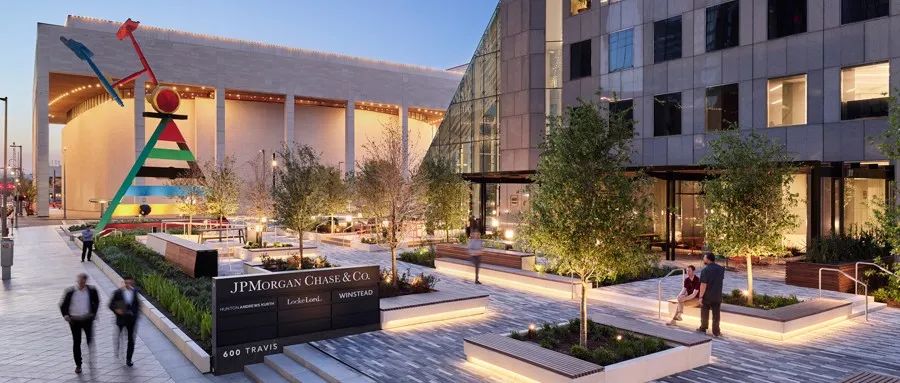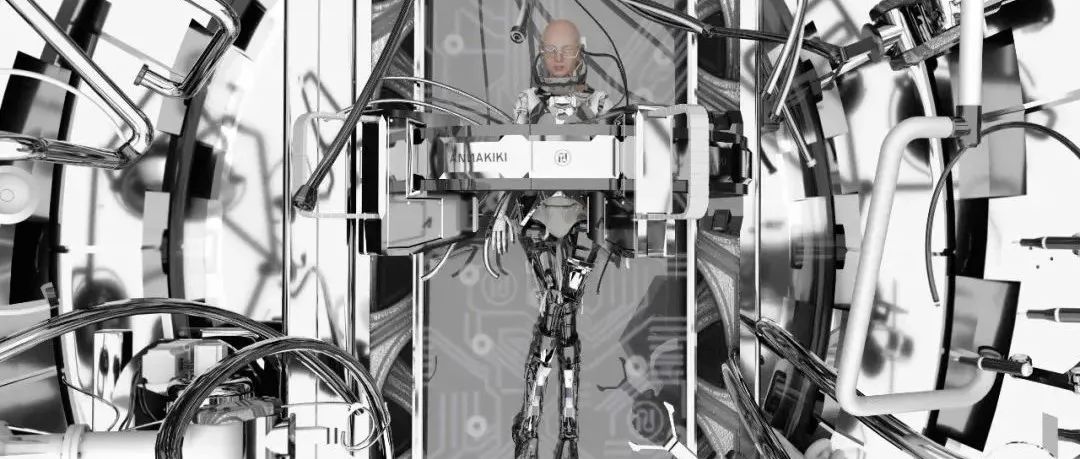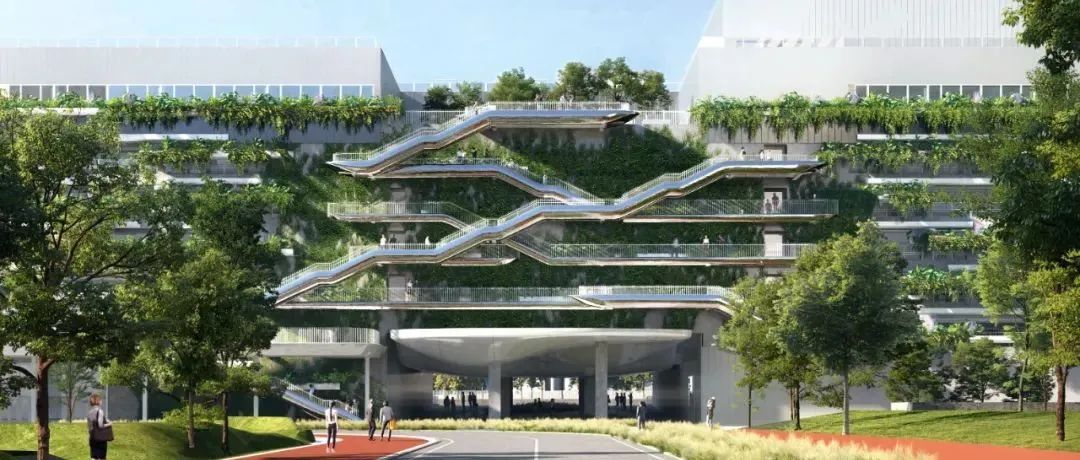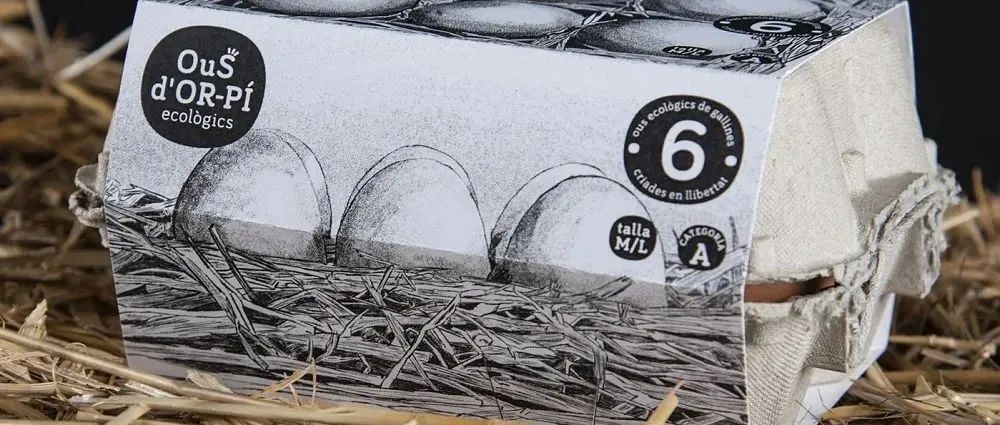HOK规划组区域总监Zach Christeson介绍了将室外空间更新包含在办公楼升级改造项目中的好处。
随着员工重返办公室,很多人希望创造更愉快的工作环境,并愿意为优质、舒适的空间支付更多费用。新冠疫情后回归办公室加速了开发商更新中央商业区传统办公楼的趋势。
升级改造这些楼宇并使其在现代办公场所市场中有竞争力,需要为在这些建筑中工作的人以及公众创造更多新的室内外便利设施。
为老旧的楼宇注入新活力、吸引不愿回到“还是老样子的办公室”的租户,开发商可以通过重新利用这些建筑附近的现有户外广场使其恢复生机来创造价值。提高人们身心健康的户外工作场所需求量很大。建筑租户也希望与社区商业、便利设施和会议空间增加联系。
挑战在于,许多城市办公楼最初几乎是被设计成“城堡”。广场的目的只是将塔楼与街景分隔,创造一条通往建筑的正式入口。
HOK提出的为改造这些广场的方法颠覆了这一模式。我们将一个原本空旷、毫无吸引力的空间还给了公共领域:邀请人们进入这个空间,而不是拒之门外。
将活力注入到以前未被充分利用、无趣的空间,鼓励了办公室员工、居民和游客之间的互动,这对健康、充满活力的城市至关重要。
将空间融入公共领域能够使其定位为市政空间、赋予目的,并有助于城市更广泛的开放空间结构。这也能够创造一个人们喜欢和引以为豪的地方。当人们进入一个空间感到愉快和激动,他们会产生一种主人意识,并更加注意保持安全。
增加便利设施和社区联系
通过对户外广场进行整修来创造视觉趣味相对简单。但好的广场重建项目之所以成功,是因为除了改善景观外,还创造了新的便利设施和社区联系。
这些项目的重要目标是在建筑和城市环境之间增添开放感并产生一种协同效应。人们不想在一栋孤立的大楼里度过他们的日子。他们希望自己是更大事物的一部分。
在建筑的广场或大厅中增加零售商业,尤其是多种餐饮选择,对激活一个空间起着巨大的作用。曾经空无一人的广场能够成为与同事或朋友见面的聚集地。
位于更活跃地区的广场,如公交车站附近,可以增加能够吸引公共交通使用者的便利设施,全天吸引这类人们。城市设计师可以确保各类人群都可以舒适安全地在广场移动,并在可能的情况下将空间与现有自行车道整合。照明、寻路和无障碍设计也使空间对每个人都更具吸引力。
充满活力的广场空间元素
为了创造一个令人愉悦的空间,户外广场需要有趣、舒适,有时还要增添一些意外惊喜。设计师可以通过以下方式实现这一点:
-
用途多样:我们通过吸引尽可能多的使用者来激活户外广场。一种方法是打造一个能够让人们互动的户外空间的策略。这些可能包括午餐或户外会议区域、各种座位选择、人们可以坐或孩子们可以玩的草坪、公共艺术,甚至棋盘。
-
质地:使用优质材料,如木材、石材、植物材料和金属,提升人们的体验。单靠混凝土和观赏草坪是无法吸引公众的。
-
利用绿植和树荫,尤其是在温暖的气候条件下。
-
设计有趣而体贴的照明使空间在夜间保持活跃和安全,使其成为酒吧和餐厅等夜生活租户的理想场所。
-
策略性地设置声音。既能滤除周围的噪音,又能激发兴趣。隐藏的嵌入式元素可以播放音乐。
-
添加令人愉悦的气味:来自植物、食物甚至空气清新剂。
-
提供高安全性的互联网接入,使空间真正成为办公室的延伸。这也能鼓励人们停留在广场。
案例 1
休斯顿摩根大通大厦
摩根大通大厦新改造的户外广场是休斯顿不断扩大的市中心公共空间网络中最新的一颗明珠。它有助于打造一个更加充满活力、适合步行的城市。这是城市景观中的一片温馨绿洲。
作为升级改造德克萨斯州最高建筑项目的一部分,Hines要求HOK的团队重新构想其宽敞的外部广场和入口体验。75层高的摩根大通大厦(前身为Travis街600号)的广场上有有史以来琼·米罗 (Joan Miro)最大的作品,名为“Personage and Birds”的雕塑。整体来看,场地缺乏便利设施和视觉趣味,而且与休斯顿市中心的街景也没有任何联系。
设计将这个未充分利用的广场转变为一个充满活力的城市花园,优化了与市中心历史、文化和交通设施的距离。室外房间以舒适的树荫和郁郁葱葱的植物为特色。减少硬景观并引入绿植,结合透水性景物来降低城市热岛效应。
广场拥有专用的无线互联网服务和私密、人性化的聚集区,是塔楼的真正室外延伸,也是员工、居民和游客的聚集目的地。多样化的座位选择让人们能够找到一个与朋友共进晚餐的地方,与同事的协作会议或独自沉思的时间。
新的树木和棚架为休息区增加了树阴,可以在晴天提供遮阳,并确保全年都有一个热闹、绿色的环境。
通过充满活力的种植种类、与几何设计形成对比的单元式铺砌以及温暖的木纹花盆、长椅和分隔墙,引入了丰富多样的纹理。两块小的人造草坪为坐着或玩游戏增添了舒适度。包括丝兰和刺梨的仙人掌在阳光下茁壮成长,创造了一种植物园体验,增强了视觉吸引力。
为了向建筑的标志性历史和原建筑设计师贝聿铭致敬,翻新升级的广场和大堂与一个新的玻璃金字塔入口结合,灵感来自巴黎卢浮宫。带有三角形图案的定制石雕位于金字塔的底部,指向主入口,提高了访客的抵达体验。梯形玻璃金字塔使阳光渗透到大厅,亲生物的设计细节使建筑内部更加明亮。
除了为大楼的租户创造一个理想的室内外工作环境外,新广场面向公众的设计使空间在夜间和周末保持活跃。
案例 2
特拉梅尔·克罗中心
HOK与J.P.摩根资产管理公司和Stream Realty Partners合作,翻新了这座50层楼高的特拉梅尔·克罗中心。建筑于1985年投入使用,是该市首屈一指的办公楼,最近被Regent Properties收购。
自塔楼建成以来,达拉斯中央商务区以创造更多步行优先的开发项目为发展趋势。设计团队面临的挑战是将这座大楼改造成综合性的目的地,使其成为临近艺术区的一个重要部分。
除了对塔楼的底层两层(建筑立面和室内空间)进行彻底改造外,该项目还包括将其场地周围的整个广场重新规划为1.4英亩(约6,070平方米)的室外聚集空间,使其重新恢复活力。设计将一个封闭的庭院变成了一个开放的场所,与相邻的艺术区和商业空间更好地互通。
新的室外空间围绕着建筑,阴凉的座位和宽敞的绿地为社区和租户活动提供了各式各样的空间。设计使改造后的建筑模糊了室内和室外、场地和街景之间的界限。一楼的社交工作区设有餐饮区和室外座位,欢迎着租户和公众。
案例 3
N大街西北1771号
位于历史悠久的杜邦环岛街区,办公楼于1967年投入使用。HOK与Stream Realty Partners合作,通过进行建筑修复和新的广场设计将这座城市地标更新为一个现代、可持续的空间。
改造前的广场是没有座位和绿化的一片石板地面。一个巨大的喷泉将广场与公共区域隔开。改造设计的重点是将位于停车场顶部的广场向街道开放,并沿弧形立面腾出空间用于种植和聚集区。
这个新入口广场着重于人性化设计尺度,类似于“花园中的房间”由树木遮蔽、并由自然材料增添了效果。设计优先考虑对街道的开放性,平衡了租户的隐私需求,同时利用了广场在整个场地的优越位置创造了一个热情友好的半公共空间。
与大楼凹形玻璃幕墙相似的带状线条蜿蜒在整个分层广场中,形成了花盆隔墙、座椅隔墙和步行道,邀请访客享受片刻喘息。景观植物的分布是为了将游客引导到主大厅,同时为一楼的办公室提供隐私空间。
宽敞、分层的开放区域为大型活动提供了便利和灵活性,为可移动的桌子或座位提供了空间。额外的绿地改善了现场的雨水管理和恢复能力。
建筑的玻璃幕墙立面提供了从内部空间到开放广场和社区的畅通无阻的视野,有助于鼓励员工到室外享受空间。
How Redeveloping Outdoor Plazas Can Bring New Life to Cities
HOK Regional Leader of Planning Zach Christeson, ASLA, describes the benefits of renewing outdoor spaces as part of office building repositioning projects.
As employers welcome workers back to the office, many are seeking to create more enjoyable workplace environments—and are willing to pay more for space in premium, amenity-filled buildings. The return-to-office from COVID-19 has accelerated the trend of developers refreshing legacy office buildings in central business districts.
Repositioning these properties to compete in the modern work environment requires creating many new amenities—indoors and out—for the people who work in these buildings as well as the public.
For developers looking to breathe new life into aging properties and attract tenants who may be hesitant to return to “the same old office,” revitalizing existing outdoor plazas adjacent to these buildings can bring great value. Outdoor workspaces, which enhance people’s health and wellness, are in high demand. Building tenants also are looking to feel more connected to neighborhood retail, amenity and meeting spaces.
The challenge is that many urban office towers were originally designed almost as citadels. The purpose of the plaza was to separate the tower from the streetscape and create a formal entryway to the building.
Our approach for redeveloping these plazas flips that dynamic, taking a space that had been empty and uninviting and giving it back to the public realm: inviting people into the space rather than signaling them to stay out.
Injecting new energy into previously underutilized, uninteresting places encourages the type of interaction among office workers, residents and visitors that is so critical to healthy, vibrant cities.
Integrating the space into the public realm gives it civic identity and purpose and contributes to the broader open space fabric of the city. It creates a place that people enjoy and take pride in. When people feel welcomed and excited to be in a space, they take ownership and are more mindful about keeping it safe.
Adding Amenities and Community Connections
It’s fairly simple to create visual interest by giving an outdoor plaza a facelift. But the best plaza redevelopment projects succeed because, in addition to enhancing the landscape, they create new amenities and community connections.
An important goal for these projects is to create a sense of openness and synergies between the building and the urban context. People don’t want to spend their days in an isolated building. They want to feel like they’re part of something bigger.
Adding retail to a building plaza or lobby—especially food and beverage options—plays a huge role in activating a place. The once empty plaza becomes a destination to meet up with coworkers or friends.
Plazas that are in more active areas, such as near transit stations, can add amenities that appeal to those users and draw people in throughout the day. Urban designers can ensure that people of all abilities can comfortably and safely move through the plaza and, when possible, integrate the space with existing bike lanes. Lighting, wayfinding and accessible design considerations also make spaces more inviting for everyone.
Elements of Vibrant Plaza Spaces
To create a pleasing space, outdoor plazas need to be interesting, comfortable and at times surprising. Designers can achieve this through:
-
Diversity of uses: We activate outdoor plazas by appealing to as many users as possible. One approach is to create a floor plan for the space with designated outdoor rooms that engage people. These may include areas for lunch or outdoor meetings, a variety of seating options, lawns where people can sit or kids can play, public art and even chess boards.
-
Texture: Investing in high quality materials like wood, stone, plant material and metals elevates people’s experiences. Concrete and ornamental grasses alone will not engage the public.
-
Introducing greenery and shade, especially in warm-weather climates.
-
Designing interesting and thoughtful lighting keeps a space activated and safe at night and makes it a desirable location for nightlife tenants like bars and restaurants.
-
Being strategic about sound, both to filter out surrounding noise and for interest. Hidden, embedded elements can play music.
-
Adding pleasing scents: From plants, food or even air freshener spritzers.
-
Providing reliable internet access so the space can act as a true extension of the office. This also keeps people in the space.
Project 1
Rejuvenating Houston’s JPMorgan Chase Tower
The newly redeveloped outdoor plaza at the JPMorgan Chase Tower is the latest jewel in Houston’s growing network of downtown public spaces and contributes to the creation of a more vibrant, walkable city. It’s a welcoming oasis within the urban landscape.
As part of a project to reposition Texas’s tallest building, Hines asked HOK’s team to re-envision its vast exterior plaza and entry experience. The existing plaza at the 75-story JPMorgan Chase Tower (formerly 600 Travis), home to the largest Joan Miro sculpture ever commissioned, “Personage and Birds,” lacked amenities and visual interest. It also had no connection to downtown Houston’s streetscape.
The design transforms this underutilized plaza into a vibrant urban garden that optimizes its proximity to downtown’s historic, cultural and transit offerings. A series of outdoor rooms feature comfortable shade and lush plantings. Reducing the hardscape and introducing green, permeable features reduces the urban heat island effect.
With dedicated wireless internet service and intimate, human-scaled gathering areas, the plaza acts as a true outdoor extension of the tower and a destination for workers, residents and visitors. Versatile seating options allow people to find a place for a meal with friends, a collaborative session with colleagues or solo contemplative time.
New trees and trellises add shade to seating areas, providing shelter on sunny days and ensuring a lively, green environment throughout the year.
A rich variety of textures are introduced through the vibrant planting palette, contrasting unit paving with geometric designs and the warm, wood-lined planters, benches and screen walls. Two small, synthetic lawns add softness for sitting or game play. Cactus species including yucca and prickly pear, which thrive in bright sun, create a botanical garden experience that enhances the visual appeal.
In a tribute to the building’s iconic history and original architect, I.M. Pei, the reimagined plaza and renovated lobby meet at a new glass pyramid entry inspired by the Louvre Museum in Paris. As visitors approach the lobby, custom stonework with a triangular motif sits at the base of the pyramid to elevate the arrival journey and designate the formal entryway to the building. The trapezoidal glass pyramid draws in sunlight and biophilic qualities to brighten the redesigned interior.
In addition to creating a desirable indoor-outdoor work environment for the tower’s tenants, the public-facing design of the new plaza keeps the space activated on nights and weekends.
Project 2
Restoring the Prominence of the Trammell Crow Center in Dallas
HOK collaborated with J.P. Morgan Asset Management and Stream Realty Partners to restore the prominence of the 50-story, postmodern Trammell Crow Center. Regent Properties recently acquired the building, which opened in Dallas in 1985 as the city’s premier office address.
Since the iconic tower was built, Dallas’s central business district has evolved into a more vibrant, pedestrian-oriented setting. The design team was challenged with transforming the property into a cornerstone destination for the city’s neighboring Arts District.
In addition to a complete makeover of the building’s first two levels (facade and interior spaces), the project included reimagining the entire plaza around its base into 1.4 acres of revitalized outdoor gathering space. The design converted a closed-off garden into an open site that is much more connected to the adjacent Arts District and commercial spaces.
New outdoor spaces surround the building. The site provides a variety of settings activated by lots of shaded seating and a large green space for community and tenant events. This newly energized building base blurs the boundaries between inside and out, as well as between the site and streetscape. A ground-floor social workspace with dining areas and outdoor seating welcomes tenants and the public.
Project 3
New Life for 1771 N Street NW in Washington, D.C.
Located in the historic Dupont Circle neighborhood, the 1771 N Street NW office building opened in 1967. In another collaboration with Stream Realty Partners, an architectural restoration and new plaza design has renewed this urban landmark into a contemporary, sustainable space.
The existing plaza was a sea of paving with no seating, no tree cover and a large fountain that walled the plaza off from the public realm. The design focused on opening the plaza, which sits atop a parking garage, to the street and freeing up space along the curved facade for plantings and gathering areas.
The new plaza creates human-scaled spaces akin to “rooms in a garden,” shaded by trees and enhanced by natural materials. Prioritizing openness to the street, the design balances the privacy needs of tenants with the creation of a welcoming, semi-public space that takes advantage of the site’s prominent location.
A serpentine ribbon that mirrors the building’s curved glass facade meanders throughout the plaza, taking form as planters, seat walls and walking surfaces, and inviting passersby in to enjoy a few moments of respite. The plantings are positioned to funnel visitors toward the main lobby while providing a privacy veil for ground-floor offices.
The spacious, tiered open areas promote accessibility and flexibility for large-scale events, providing room for removable tables or seating. The additional green space improves the site’s stormwater management and resilience.
The building’s glass curtain facade offers unobstructed views from the interior space to the open plaza and neighborhood, helping to draw workers outside to enjoy the space.
相关阅读 Project Story ++
本文来自微信公众号“HOK贺克”(ID:hok_ap)。大作社经授权转载,该文观点仅代表作者本人,大作社平台仅提供信息存储空间服务。












